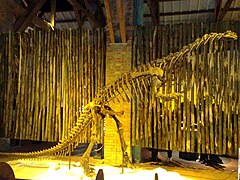Massopoda
| Massopods | |
|---|---|

| |
| Mounted skeleton of Lufengosaurus | |
| Scientific classification | |
| Domain: | Eukaryota |
| Kingdom: | Animalia |
| Phylum: | Chordata |
| Clade: | Dinosauria |
| Clade: | Saurischia |
| Clade: | †Sauropodomorpha |
| Clade: | †Plateosauria |
| Clade: | †Massopoda Yates, 2007 |
| Subgroups[4] | |
| |
Massopoda is a clade of sauropodomorph dinosaurs which lived during the Late Triassic to Late Cretaceous epochs. It was named by paleontologist Adam M. Yates of the University of the Witwatersrand in 2007. Massopoda is a stem-based taxon, defined as all animals more closely related to Saltasaurus loricatus than to Plateosaurus engelhardti.[5] Sauropodiformes is a more exclusive stem-based clade within Massopoda, defined as "the most inclusive clade containing Saltasaurus but not Massospondylus".[4]
The name Massopoda, from Latin massa 'lump'; from Ancient Greek πους (pous) 'foot', is also contraction of Massospondylidae and Sauropoda, two disparate taxa in the clade.
Classification
[edit]Yates assigned the Massopoda to Plateosauria. Within the clade, he assigned the families Massospondylidae (which includes the relatively well-known dinosaur Massospondylus) and Riojasauridae (which includes Riojasaurus) as well as the Sauropoda.[6]
The following is a cladogram from an analysis presented by Oliver W. M. Rauhut and colleagues in 2020:[7]
| Massopoda | |
References
[edit]- ^ a b Apaldetti, C.; Martinez, R. N.; Alcober, O. A.; Pol, D. (2011). Claessens, Leon (ed.). "A New Basal Sauropodomorph (Dinosauria: Saurischia) from Quebrada del Barro Formation (Marayes-El Carrizal Basin), Northwestern Argentina". PLOS ONE. 6 (11): e26964. Bibcode:2011PLoSO...626964A. doi:10.1371/journal.pone.0026964. PMC 3212523. PMID 22096511.
- ^ Barrett, Paul M.; Chapelle, Kimberley E.J.; Sciscio, Lara; Broderick, Timothy J.; Zondo, Michel; Munyikwa, Darlington; Choiniere, Jonah N. "A new Late Triassic sauropodomorph dinosaur from the Mid-Zambezi Basin, Zimbabwe". Acta Palaeontologica Polonica. 69 (2): 227–241. doi:10.4202/app.01100.2023.
- ^ Zhang, Q.; Jia, L.; Wang, T.; Zhang, Y.; You, H. (2024). "The largest sauropodomorph skull from the Lower Jurassic Lufeng Formation of China". PeerJ. 12. e18629. doi:10.7717/peerj.18629. PMC 11646418.
- ^ a b McPhee, B. W.; Yates, A. M.; Choiniere, J. N.; Abdala, F. (2014). "The complete anatomy and phylogenetic relationships of Antetonitrus ingenipes (Sauropodiformes, Dinosauria): Implications for the origins of Sauropoda". Zoological Journal of the Linnean Society. 171: 151–205. doi:10.1111/zoj.12127.
- ^ Yates, Adam M. (2007). "Solving a dinosaurian puzzle: the identity of Aliwalia rex Galton". Historical Biology. 19 (1): 93–123. Bibcode:2007HBio...19...93Y. doi:10.1080/08912960600866953. S2CID 85202575.
- ^ Yates, Adam M. (2007). Barrett, Paul M.; Batten, David J. (eds.). "The first complete skull of the Triassic dinosaur Melanorosaurus Haughton (Sauropodomorpha: Anchisauria)". Evolution and Palaeobiology. 77: 9–55. ISBN 978-1-4051-6933-2.
- ^ Rauhut, O. W. M.; Holwerda, F. M.; Furrer, H. (2020). "A derived sauropodiform dinosaur and other sauropodomorph material from the Late Triassic of Canton Schaffhausen, Switzerland". Swiss Journal of Geosciences. 113 (1): 8. doi:10.1186/s00015-020-00360-8. S2CID 220294939.












